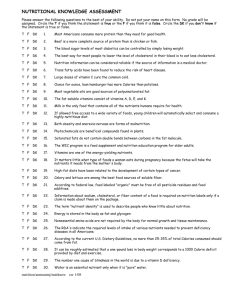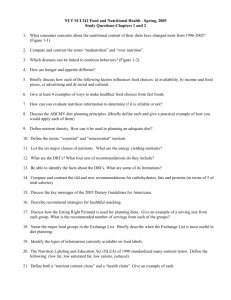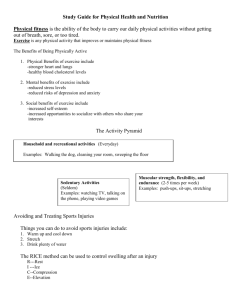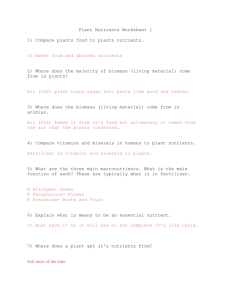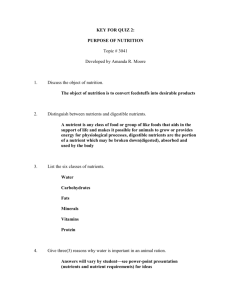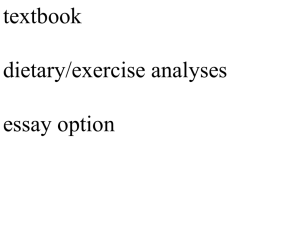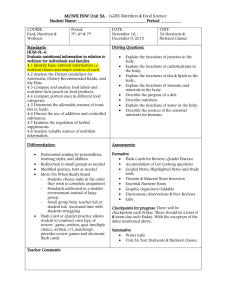Chapter 12, Nutrients
advertisement
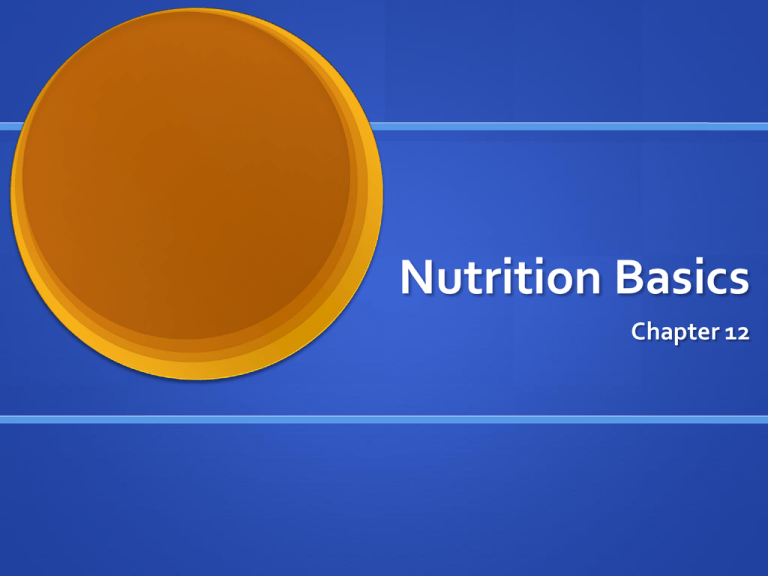
Nutrition Basics Chapter 12 Nutrition Basics Objectives Relate earlier scientific findings to today’s understanding of nutrition. Identify and briefly describe essential nutrients. Relate the understanding of nutrition to physical well-being. Vocabulary Essential nutrients Nutrient dense Nutrients Nutrition Recommended Dietary Allowances (RDAs) scurvy Nutrition History Highlights Ancient people credited food for having magical powers Around 400 B.C., Hippocrates, “the father of modern medicine,” taught that people could learn what was good for them by reasoning from observable facts Studies led him to believe that foods contain life- giving substance Not until the mid 1700’s that the scientific method proved him right An Early Discovery British sailors suffered from lack of Vitamin C, which caused circulatory disease, bleeding gums, weakened blood vessels, and extreme fatigue. This was also fatal. The name for this condition was scurvy. A physician set up an experiment to find a cure and the illness only disappeared in the sailors that ate lemons and limes. This experiment gave the sailors a nickname called limeys, which is applied to British citizens today. Nutrition The science of how the body uses food Nutrients Are the materials for the building and maintenance of the body tissue, and regulate body processes. The body needs the correct amounts of specific nutrients from 6 categories. Each one of these nutrients performs specific functions in the body. 6 Classes of Nutrients Carbohydrates Proteins Fats Water Vitamins Minerals Calories Three nutrients give us ENERGY or “fuel for the body”. A unit of ENERGY is called a CALORIE (kcal) Notice that fat is double the calories per gram 1 gm Carbs = 4 kcal 1 gm Protein = 4 kcal 1 gm Fat = 9 kcal Carbohydrates Best Sources Benefits for the Body Bread Body’s main source of Cereals energy Provides fiber for digestion & elimination Fruits Potatoes Rice Sweets chips sugar Proteins Best Sources Benefits for the Body Meat Build and repair tissue Poultry Help regulate body Fish processes Help make antibodies to fight disease Legumes Nuts Milk Cheese Eggs Fats Best Sources olive oil canola oil vegetable oil avacados nuts Benefits for the Body Carry fat-soluble vitamins through the body Some supply essential fatty acids for normal growth and skin health Vitamins Best Sources Different in all foods Benefits for the Body Each vitamin has it’s special function. They help regulate body processes Minerals Best Sources Different in all foods Benefits for the body Help regulate body processes Water Best Sources Benefits for the Body Water Carries nutrients to the Fruits body cells. Carries waste products away. Helps keep the body cool. Vegetables Variables which affect nutrient needs: 1. Age 2. Gender 3. Activity Level 4. Climate 5. Health 6. State of nutrition Nutrient Dense Nutrient dense food supply many nutrients that are critical to good health in comparison to their low-tomoderate number of calories. RDA’s (RDA) Recommended Dietary Allowances – Is a table supplied by the US government to give adequate amounts of specific nutrients needed by most healthy people. First established over fifty years ago. Supplies a detailed description of nutrient needs of eighteen population groups. Currently covers protein, ten vitamins and seven minerals Food Labeling
